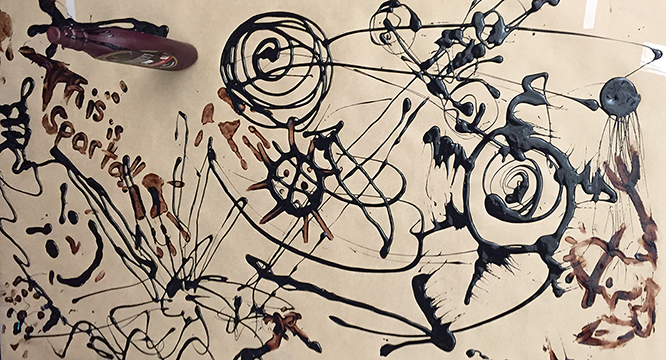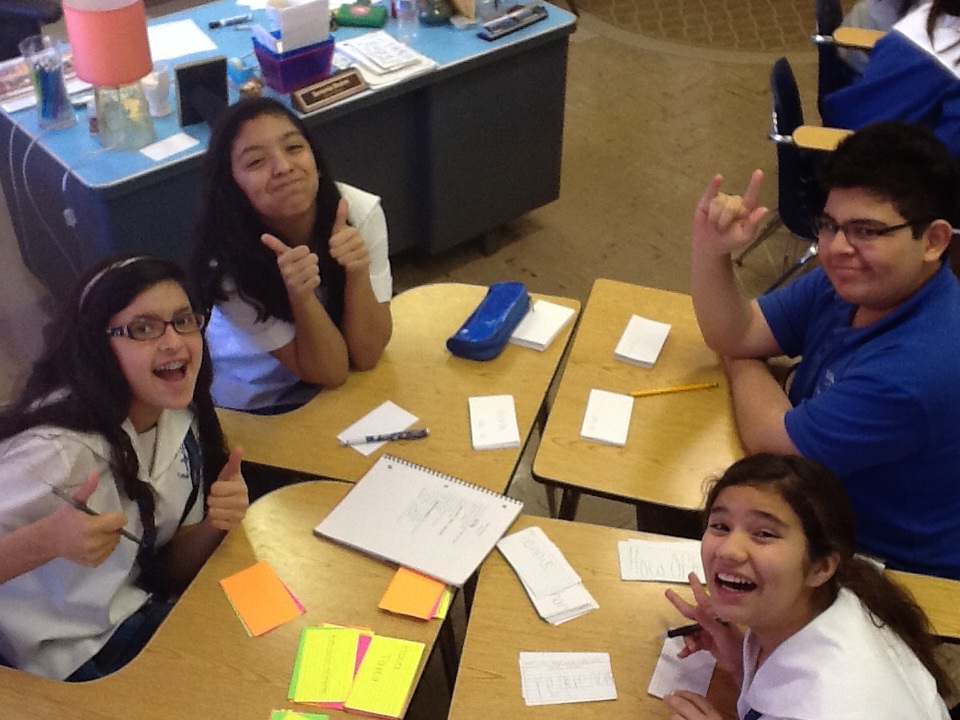Sarah Guayante, a student at St. John’s University and a T&W editorial intern, is interviewing teaching artists who take part in the TATIP* program. Martin Urbach, a percussionist who used to teach at Marquis Studios and now teaches full-time, facilitated the TATIP elective seminar on Teaching for Special Needs and Universal Design alongside Phil Alexander of Brooklyn Arts Council.
Teachers & Writers: How do your roles as teacher and musician overlap? Does your experience as a teacher influence your work as an artist?

Martin Urbach: I don’t necessarily view myself as an educator or as a musician separately. Instead, I view myself as a musician that uses music to educate students on how to use music as a vehicle for social justice and to create strong interpersonal relationships. So, I view each job as a continuation of the other. Through teaching, I try to use music to educate children. Through playing music, I view myself as an educator for society.
T&W: When you’re in the classroom, what is the most important thing about making music that you want to communicate with your students?
MU: When I’m in the classroom, I want to build an environment that is safe for us all to collaborate together. Music, for me, is fun. But, it is a time for us to be able to be together in finding life questions. How can we work together as a team? How can we disagree respectfully? Or, how can we be more open-minded? As well as, how can we do our best? How can we stay on point while we are trying to do our task? If we can build an environment that is safe and fun for us all to collaborate, then I feel like we’ve done our job.
T&W: In your experience, what does including arts education in the curriculum give to students?
MU: Arts education gives the students several points of entry for information. It also allows some students to think outside the box, inside the box, around the box. Basically, it gives students the opportunity to figure out different answers for the same question. Or, even different questions for the same answer.
T&W: Did you have that kind of experience as a student?
MU: My arts education in school was quite different. My arts education came from an after-school program back in Bolivia, where I grew up. So, in a way, it did. In a way, I used after-school time playing guitar or playing drums as a way to figure out my own life. In a way, it did it for me, but not in the school setting. That’s why I do what I’m doing, because I didn’t have anything and I wish I had.
T&W: Can you say more about a time that you’ve seen a student make a connection through art that couldn’t have happened without it?
MU: I teach at a school for students with special needs. Yesterday, we were doing a holding-the-microphone lesson. They’re putting on a play and they’re using microphones. I have students that are non-verbal and one of my students wanted me to put on this Adele song. But, he’s non-verbal so he doesn’t use words. He uses an iPad to communicate to us, so, he typed up the words to the song, which he knew the lyrics to. Then, he put the microphone up to the iPad speaker. After, I started to sing along with the track and then he began singing in perfect tune and in perfect pitch. He was mumbling the words, though so we practiced one word at a time.Then, he just did it. He made that connection. He sang the words, which he knew because he typed them. So, art, like singing and music, actually helped him bridge his language.
T&W: What sparks your lesson plans? Are there any resources that you use that you would recommend to other teaching artists?
MU: I really love social media and I try to stay very active on Facebook and Instagram. Anytime I have a question, about a lesson that I’m doing or resources, I put up a post on Facebook and, within minutes, I have four or five comments from people saying, “Hey, you should do this,” or “Hey, you should try this other thing.” It’s a way to build a bridge between the insulated space of the classroom and the whole world outside.
I also like to create interdisciplinary lessons. For example, I was trying to mix the concept of flow and I realized like, “Hey, teaching kids about Jackson Pollock could be a really nice way of teaching flow in music.” So, I like to also think of visual arts and theatre, go outside of my own art form.
There’s also websites, like Edutopia, that are full of great lesson ideas.
T&W: When you were talking about the concept of flow, you said you were teaching Jackson Pollock. How did you connect those two in your lesson plan?
MU: In music, for example, if you’re trying to teach students about flow in lyric writing or you’re teaching about flow in melodic performance through teamwork, it’s really nice to talk about lines that a painter might make. Using a video of Jackson Pollock squirting and throwing paint on a canvas–not necessarily going from point A to point B–can be a nice way of showing the students that they don’t have to have a structure like ‘once upon a time.’ You can start with just letting it happen and then, from there, get your fingers dirty and start rearranging the lines.
It’s not only fun for students to do that, but it’s meaningful because they get to experience it in their multiple intelligences. They get to experience lyric creation visually and kinesthetically. Then, you can scaffold that lesson by adding adjectives or by adding different verbs or synonyms. And, all of a sudden, you have students writing poetry or writing lines and lyrics that are much deeper and have much more flow than if you just started with a blank piece of paper.
T&W: You co-facilitated the TATIP Elective Seminar, with Phil Alexander covering Universal Design for Learning and you leading the Special Needs workshop. If there was one thing that you wanted every single teaching artist there to understand, what would it be?
MU: Teach the individual, not the subject. As teaching artists we, a lot of times, get too involved in teaching music or mess-making or poetry when, in reality, we are teaching individuals. We are teaching students. We’ve got to make sure that we are able to recognize who is in the room and, quickly, react to them and be responsive to what their needs are. There might be a student that needs to just close his eyes for five minutes. Those five minutes may be all he needs to come back in calmly and do this lesson. So, it’s really important to recognize that they are full sets of human beings that they have needs. In a way, they don’t need us to tell them how to live their lives. The only thing that they really need is for us to create an environment that, whatever we’re telling them, they’ll feel interested in and they’ll want to partake in.
To see Martin Urbach in action, check out his YouTube channel.
*The “TATIP Cohort” is part of Community-Word Project’s eight-month Teaching Artist Training and Internship Program (TATIP). This select group of New York City arts education organizations is a partnership initiative to expand professional development not only for the TATIP students, but also for teaching artists working with these organizations. Our mission is to combine efforts to better prepare artists to bring arts to city classrooms. With professional development seminars that deconstruct the dynamics of teaching artistry in a variety of settings and focus areas, the January-May Saturday sessions are geared towards developing new ways of stimulating creativity and understanding in students.
The TATIP Cohort partners with Community-Word Project, include:
Brooklyn Arts Council
Center for Arts Education
Dreamyard Project
FreeArts NYC
MagicBox Productions
Marquis Studios
Maxine Greene Center
National Dance Institute
New Victory Theatre
Teachers & Writers Collaborative
Wingspan Arts
Voices Unbroken
Teachers & Writers Magazine is published by Teachers & Writers Collaborative as a resource for teaching the art of writing to people of all ages. The online magazine presents a wide range of ideas and approaches, as well as lively explorations of T&W’s mission to celebrate the imagination and create greater equity in and through the literary arts.



